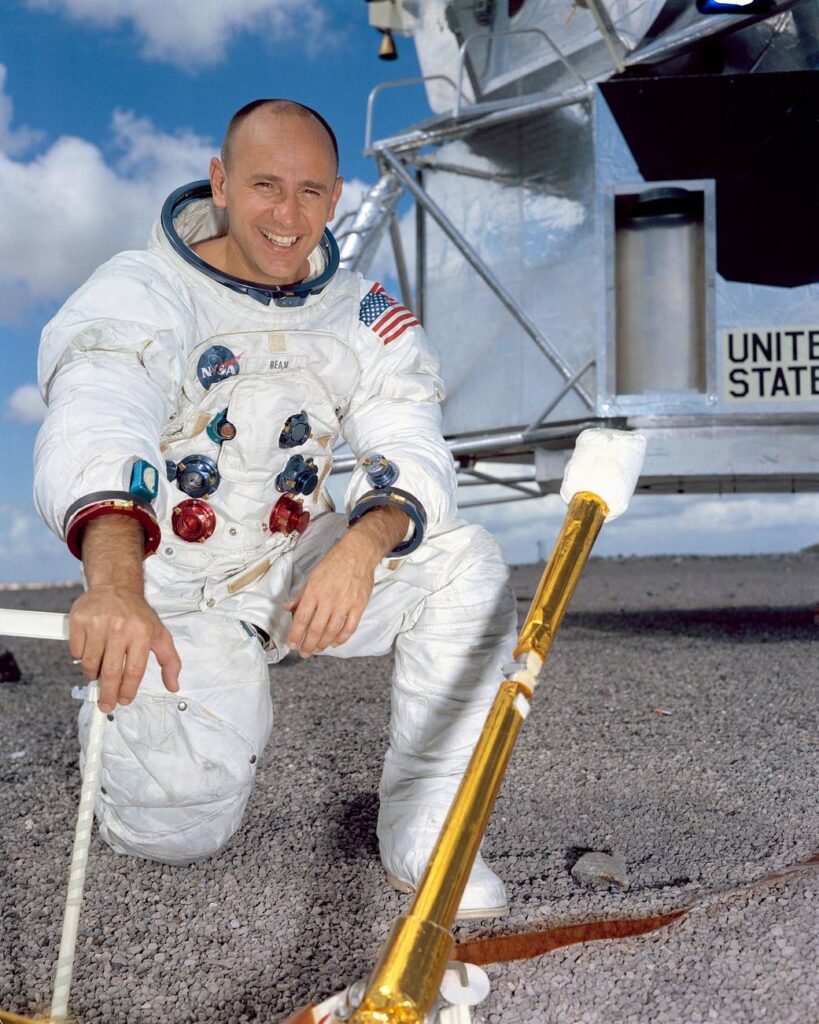Piloted the lunar module on Apollo 12, the second lunar landing mission.
Alan L. Bean was born in Wheeler, Texas, on March 15, 1932. He graduated from Paschal High School in Fort Worth, Texas and in 1955 received a Bachelor of Science degree in Aeronautical Engineering from the University of Texas. At the university, Bean was an ROTC student and was commissioned upon graduation.
After completing flight training, Bean was assigned to a jet attack squadron at the Naval Air Station in Jacksonville, Florida. He later attended the Navy Test Pilot School and flew as a test pilot for several types of Navy aircraft. In October 1963, Alan Bean was selected by NASA to be an astronaut. He holds eleven world records in space and astronautics. Captain Bean has flown 27 types of military aircraft as well as many civilian airplanes. He has logged more than 7,145 hours flying time, including 4,890 hours in jet aircraft.
Alan Bean was the Lunar Module pilot on Apollo 12, the second manned landing on the Moon. Launched from Kennedy Space Center, Florida on November 14, 1969, Apollo 12 entered lunar orbit after a five-day flight of some 250,000 miles. Bean and Mission Commander Pete Conrad landed the Lunar Module Intrepid on the Moon’s Ocean of Storms. They explored the lunar surface, deployed several experiments, and installed the first nuclear power generator station on the moon to provide the power source for the experiments while Command Module pilot Richard Gordon remained aboard the Command Module Yankee Clipper in lunar orbit photographing landing sites for future missions.
On November 20, after 31 hours and 31 minutes on the moon, Intrepid successfully lifted off with 76 pounds of lunar samples. After reuniting with Gordon, Bean, and Conrad jettisoned the empty Intrepid, which fell back to the lunar surface. The Yankee Clipper splashed down safely in the Pacific Ocean on November 24, after a mission of ten days, four hours and 36 minutes.
Captain Bean’s next space mission was as commander of Skylab Mission II (SL-3), the second crew of America’s first space station from July 29 to September 25, 1973. With him on the record-breaking, 59-day, 24,400,000-mile flight were Dr. Owen K. Garriott and Lieutenant Colonel Jack R. Lousma. During the mission, Bean tested a prototype of the Manned Maneuvering Unit and led three spacewalks. Mission II accomplished 150% of its forecast goals. On his next assignment, Captain Bean was backup Spacecraft Commander of the United States flight crew for the joint American-Russian Apollo-Soyuz Test Project.
During his two missions, Alan Bean logged 1,671 hours, and 45 minutes (over 70 days) in space including ten and a half hours of extravehicular activity. Captain Bean retired from the Navy in October 1975 but continued as head of the Astronaut Candidate Operations and Training Group within the Astronaut Office in a civilian capacity. He resigned from NASA in June 1981 to devote his full time to painting. He said his decision was based on the fact that, in his eighteen years as an astronaut, he was fortunate enough to visit worlds and see sights no artist’s eye, past or present, has ever viewed firsthand, and he hoped to express these experiences through the medium of art.
Captain Bean helped establish eleven world records in space and astronautics. He has received two NASA Distinguished Service Medals, and the Navy Astronaut Wings and two Navy Distinguished Service Medals. He is also a recipient of the Rear Admiral William S. Parsons Award for Scientific and Technical Progress, the University of Texas Distinguished Alumnus Award and Distinguished Engineering Graduate Award, the Godfrey L. Cabot Award, the National Academy of Television Arts and Sciences Trustees Award, the Texas Press Association’s Man of the Year Award for 1969, the City of Chicago Gold Medal, the Robert J. Collier Trophy for 1973, the Federation Aéronautique Internationale’s Yuri Gagarin Gold Medal for 1973, and the V.M. Komarov Diploma for 1973, the Dr. Robert H. Goddard Memorial Trophy for 1975, the AIAA Octave Chanute Award for 1975, and the AAS Flight Achievement Award for 1974.

